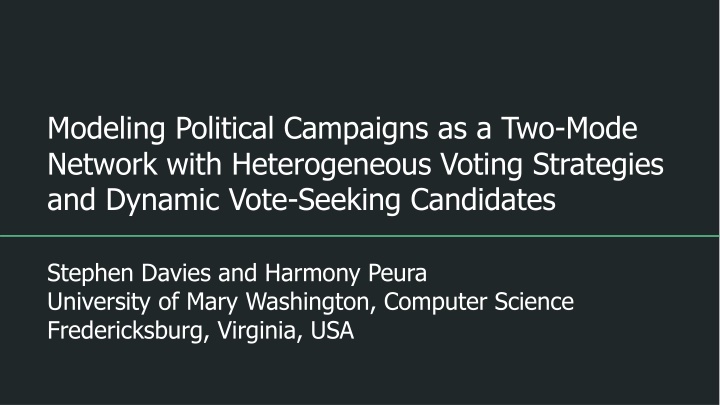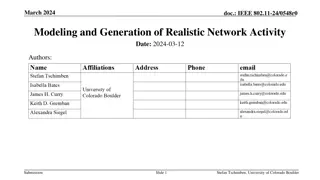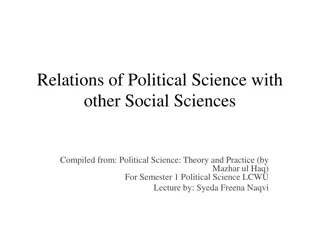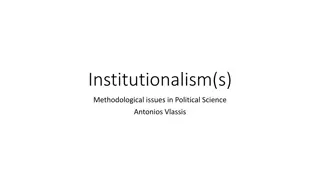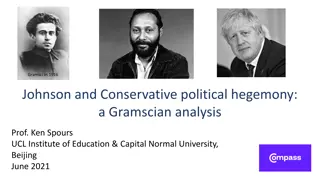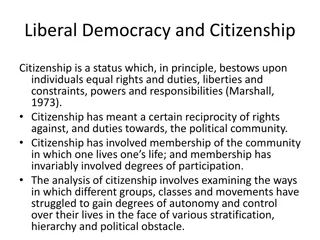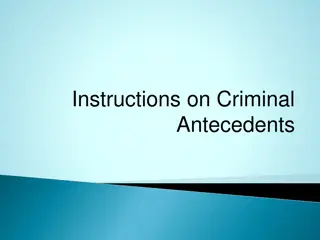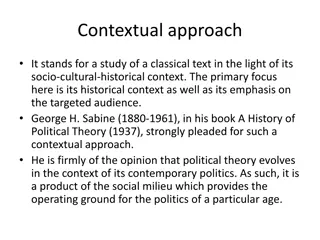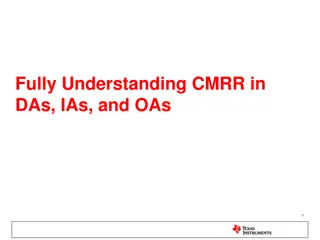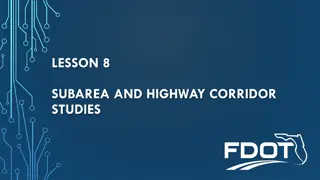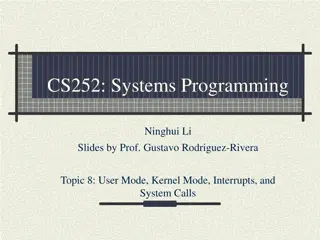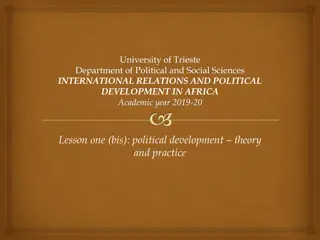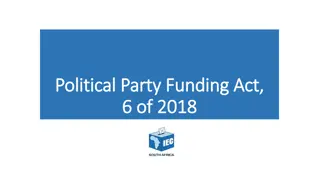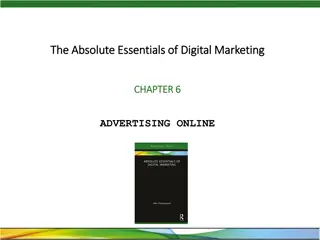Modeling Political Campaigns as a Two-Mode Network
This study delves into the dynamics of political campaigns using a two-mode network model with heterogeneous voting strategies and dynamic candidates seeking votes. The research explores how voter agents and candidate agents interact, influencing each other's opinions across various issues and party affiliations. The binary voter model and cross-issue influence among agents are examined to understand rational voting behavior and election outcomes.
Download Presentation

Please find below an Image/Link to download the presentation.
The content on the website is provided AS IS for your information and personal use only. It may not be sold, licensed, or shared on other websites without obtaining consent from the author.If you encounter any issues during the download, it is possible that the publisher has removed the file from their server.
You are allowed to download the files provided on this website for personal or commercial use, subject to the condition that they are used lawfully. All files are the property of their respective owners.
The content on the website is provided AS IS for your information and personal use only. It may not be sold, licensed, or shared on other websites without obtaining consent from the author.
E N D
Presentation Transcript
Modeling Political Campaigns as a Two-Mode Network with Heterogeneous Voting Strategies and Dynamic Vote-Seeking Candidates Stephen Davies and Harmony Peura University of Mary Washington, Computer Science Fredericksburg, Virginia, USA
An Introduction to Opinion Dynamics: The Binary Voter Model 1. Each agent holds one binary opinion. 1. Agents interact with neighboring agents on a social network. 1. During an interaction, one agent adopts the other agent s opinion. Fun fact: the Binary Voter Model always leads to uniformity. R. A. Holley and T. M. Liggett, Ergodic theorems for weakly interacting infinite systems and the voter model, The annals of probability, pp. 643 663, 1975.
An Overview of the Model A two-node network: voteragents, and candidateagents. An agent s opinions on the various issues of the day are represented by a vector of reals on [0,1]. (This defines an opinion space.) Neighboring voters influence one another. Candidates chase voters. Each N steps, an election is held. A voter is said to have voted rationally if they chose the candidate whose opinion vector is closest to their own (Euclidean distance). An election outcome is said to be rational if the winning candidate is the candidate who would have won had all voters voted rationally.
Voter Agents: Cross-Issue Influence 1 2 3 Each agent has a vector of abstract opinions and a party affiliation. When neighboring agents interact, they compare opinions on a random issue. If they are roughly in agreement, Y will sway X s opinion on a different issue. X: [0.1, 0.8, 0.5] X: [0.4, 0.8, 0.5] X: [0.1, 0.8, 0.5] Y: [0.7, 0.9, 0.3] J. Mittereder, R. S. W. Carroll, B. Frulla, and S. Davies, Exploring the Impact of Social Network Density and Agent Openness on Societal Polarization, in Proceedings of the 2021 Conference of The Computational Social Science Society of the Americas, Z. Yang and E. von Briesen, Eds., in Springer Proceedings in Complexity. Cham: Springer International Publishing, 2022, pp. 71 84.
Party Affiliations All agents have a party affiliation. Candidates are each given their own party. Voters initial party affiliations correspond to the candidate closest to them in opinion space. Candidate agents never switch parties. Voters may switch parties if they move close enough to another party s centroid.
Party Affiliations Party centroid
Party Affiliations Party centroid
Elections: How do Voters Make Decisions? How do voters choose who to vote for? Often, via a satisficing decision. They chose the candidate that is good enough, making trade-offs between a good decision and an easy decision. Voters use a voting strategy to vote for a candidate. We developed four algorithms to capture different kinds of satisficing observed in the political science literature. Simon, H. A. (1956). Rational choice and the structure of the environment. Psychological Review, 63(2), 129-138
Voting Strategies Rational - Choose candidate closest to voter s opinion vector. Party - Vote based purely on party affiliation. Fast and Frugal (F&F) - Single-issue voters: F&F 1 - Vote based on their own core issue. F&F 2 - Vote based on the society s current hot topic issue. The voting algorithm distribution represents the proportion of the electorate deploying each of these four strategies. D. P. Redlawsk, A Citizen s Guide to the Political Psychology of Voting, 1st edition. New York: Routledge, 2020.
Simulation Parameters and Variables Parameters Independent Variables Chasers vs. non-chasers Chase radius Voting algorithm distributions Suite size of 1200 400 steps 50 steps between elections 20 voters 3 candidates 3 issues Baseline voting algorithm distribution: rational, party, F&F Dependent Variables Election winners Chase distance Rationality
Chasing provides maximum benefit with a rational electorate One Chaser Two Chasers
Chasing is not (as) advantageous with a Party-line or Fast & Frugal electorate Fast & Frugal Electorate Party-line Electorate
Multiple chasing candidates reduce one anothers gains with a varied electorate One Chaser Two Chasers
Aggressive Chasing Provides a Slight Advantage Red: 0.1 chase radius Blue: 0.2 chase radius Red: 0.1 chase radius Blue: 0.2 chase radius
Rationality Over Time with an Electorate of all Party-line Voters No chasers One chaser Three chasers
Discussion The efficacy of candidate chasing depend crucially on the makeup of the model s electorate. Chasing is extremely beneficial with a rational electorate. Diminishing benefits when two candidates are chasing votes or the electorate is not rational. In the model, party voting and single-issue voting reduce the rationality of elections. When candidates chase an electorate that is not rational, they actually decrease the rationality of the outcomes over time.
Modeling Political Campaigns as a Two-Mode Network with Heterogeneous Voting Strategies and Dynamic Vote-Seeking Candidates Stephen Davies and Harmony Peura University of Mary Washington, Computer Science Fredericksburg, Virginia, USA
